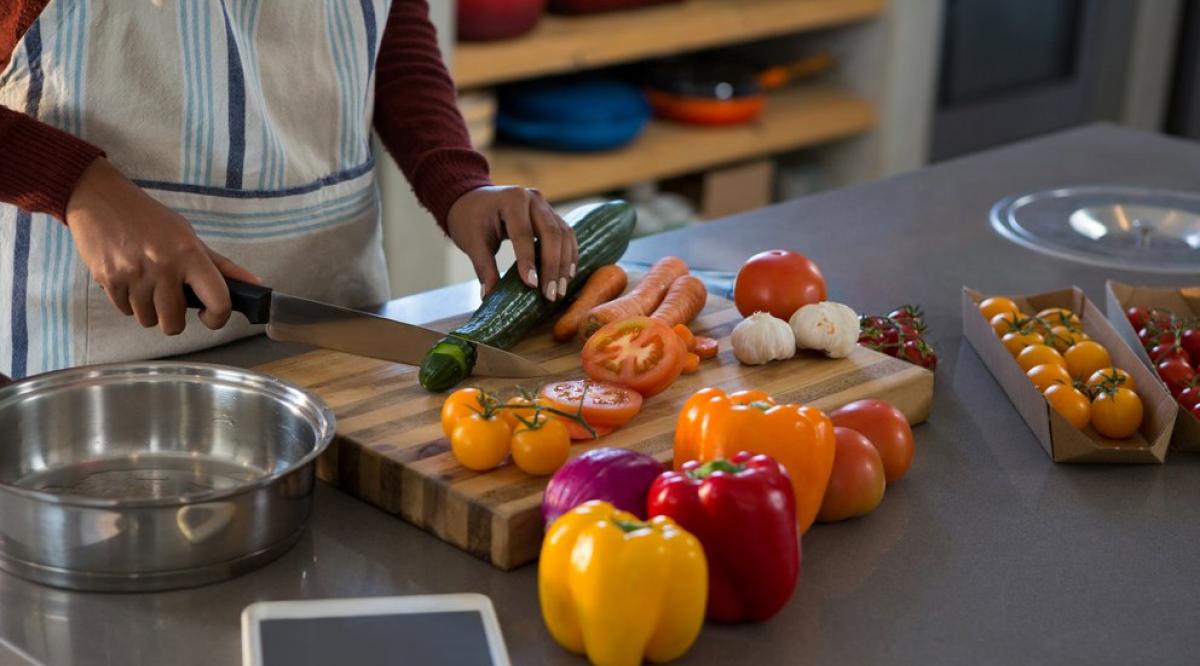When second-year medical student Thien Nguyen signed up for the Teaching Kitchen class at the University of California, Los Angeles (UCLA), he knew how to cook the basics—simple stir fries and sweet potatoes—but he was no genius in the kitchen. In one of the first classes, held at a local Sur La Table and taught by nutrition lecturer and chef Janet Leader, MPH, RD, the class was attempting poached eggs.
“I dropped the eggs in and the whole pot spun out and we were covered in egg whites. What was left in the water looked like yellow gloop,” Nguyen said, chuckling at the memory.
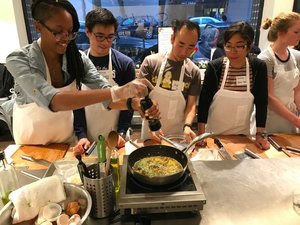
Master chefs they are not, but the students did come away with some practical, hands-on training in healthy meal preparation. They’re also part of an emerging trend at medical schools across the country, one that teaches students how to cook so they will be equipped not only to take better care of themselves but also to counsel patients on the role that good nutrition plays in improving health outcomes.
Indeed, research shows that nutrition counseling by physicians does make a difference. One 2014 analysis of data from the National Health and Nutritional Examination Survey found that overweight and obese patients whose doctors spoke with them about their weight were twice as likely to lose at least 5% of their body mass over the following year.
And yet, less than half of primary care physicians track body mass index or provide nutrition education for their patients, according to a 2011 survey published in the American Journal of Preventive Medicine.
“While medical students often learn how to talk to patients about behaviors like alcohol use or smoking, when it comes to talking to patients about nutrition or weight loss, we all felt paralyzed before taking the class.”
Natalja Rosculet, fourth-year student
University of Michigan Medical School
Physicians can have a tremendous impact on their patients, but not all of them may be comfortable with healthy meal preparation, said Leader, who is also the associate director of nutrition programs in the community health sciences department of the Fielding School of Public Health. “Before the class, students weren’t confident about their skills or their ability to teach patients about nutrition and cooking. Now they have simple, specific suggestions for meal planning they can give to patients.”
Indeed, the UCLA class, which is open to students from four schools—the David Geffen School of Medicine, the Fielding School of Public Health, the School of Dentistry, and the School of Nursing—has already made a difference. The percentage of students who felt equipped to advise patients on nutrition increased from 6% to 53% after taking the three-week elective, according to a research poster on the course presented by doctoral student Miranda Westfall, MPH, RD.
Curriculum for a moveable feast
While nutrition education has always been part of the medical school curriculum, “some schools have recently begun to explore more creative ways to integrate these competencies into the curricula,” said Lisa Howley, PhD, senior director of strategic initiatives and partnerships for the AAMC.
Timothy Harlan, MD, executive director of the Goldring Center for Culinary Medicine at Tulane University in New Orleans, is at the forefront of these efforts. Under Harlan’s leadership, Tulane designed an eight-module course and currently licenses its culinary medicine curriculum to 39 medical schools, 9 residency programs, and 2 nursing schools.
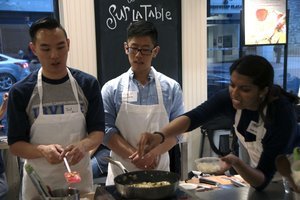
“The misperception is that cooking healthy is hard, time consuming, and more expensive. All of our programming shatters that myth,” Harlan said. The physician-chef is passionate about the potential to teach medical students and residents how to help patients with a myriad of ailments that plague patients today—not only heart disease but diabetes, acid reflux, celiac disease, and irritable bowel syndrome.
His research shows that his approach may be effective. Harlan led a 2015 study published in Advances in Preventive Medicine, which found that students who took culinary medicine courses not only became more comfortable with nutrition counseling but also ate more dark green vegetables themselves, compared to a control group of Tulane medical students that did not take the elective courses. Since 2016, Tulane medical students have been required to take culinary medicine classes and starting in the fall of 2018, students will be required to take four hands-on culinary modules.
The University of Michigan Medical School adopted part of the Tulane curriculum. The two-week-long elective consists of both kitchen and classroom sessions and includes sections on diets, like the Mediterranean and DASH diets, and food insecurity. The students learn nutrition interviewing techniques that can be used in clinic as well as how to assess patient cooking skills.
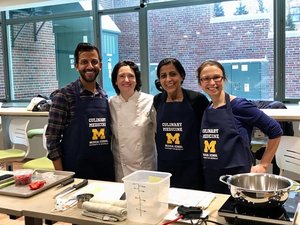
“The students get a solid understanding of how to counsel long-term sustainable changes,” said Brigid Gregg, MD, assistant professor of pediatrics and communicable diseases in the Pediatric Endocrinology Division, who helped create and teach the pilot program along with Roma Gianchandani, MBBS, associate professor of internal medicine in the school’s Division of Metabolism, Endocrinology & Diabetes, and fourth-year medical student Natalja Rosculet.
Interestingly, while medical students often learn how to talk to patients about behaviors like alcohol use or smoking, when it comes to talking to patients about nutrition or weight loss, “we all felt paralyzed” before taking the class, Rosculet said.
Healthy docs, healthy patients
Formal nutrition training could benefit more than just the current class of medical students. One 2017 American College of Cardiology survey of more than 900 cardiologists, published in the American Journal of Medicine, found that 90% of respondents reported receiving either no or minimal nutrition education during their cardiology training and 31% did not recall receiving any nutrition information during medical school. Yet 95% said they believed it was their responsibility to deliver basic nutrition education to their patients.
To that end, David Eisenberg, director of culinary nutrition at the Harvard T.H. Chan School of Public Health, created a continuing medical education course that helps translate nutrition science into specific advice for patients. More than 6,000 medical professionals have taken the course.
“Doing it yourself is educationally much more impactful than watching others do something or talk about it.”
David Eisenberg, MD
Harvard T.H. Chan School of Public Health
In 2015, Harvard Chan School and the Culinary Institute of America launched the Teaching Kitchen Collaborative, a program that uses teaching kitchens to show medical students, residents, and others how to counsel patients about exercise, mindfulness, and behavior change. “If we can teach medical students how to hold a knife and cook a healthy, delicious, affordable meal themselves, I think it changes the way they view a discussion of diet, food, nutritional habits, and nutrition assessment for patients,” Eisenberg said. “Doing it yourself is educationally much more impactful than watching others do something or talk about it.”
UCLA is one of 31 members of the Teaching Kitchen Collaborative, as is the University of Minnesota Medical School.
Minnesota’s Kate Shafto, MD, attended two Healthy Kitchen, Healthy Lives conferences in Napa Valley, Calif., and was inspired to submit an educational grant proposal to the American Academy of Pediatrics. She started a pilot course with $1,500 in January 2016. The Food Matters for Health Professionals class is now offered by the University of Minnesota's Earl E. Bakken Center for Spirituality and Healing for one credit and is open to all health professional graduate students.
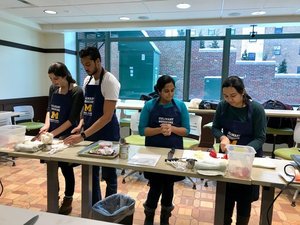
“We had a magical experience,” Shafto recalls of that initial class, which was held in the kitchen of an agricultural food hub, the Good Acre, where local farmers can sell their produce to universities and institutions. At the beginning of the course, each of the students shared a food story; some talked about the foods their grandmothers made, others the gardens they loved or eating fast food most nights.
As a final project, the students designed a sample meal for a case study patient and created a patient education handout.
Second-year medical student McKenna Campbell-Potter’s group had a case study patient with diabetes and hypertension. The assignment was to create a heart-healthy meal that the patient would enjoy. Campbell-Potter and her group whipped up mashed cauliflower with spices and olive oil, salmon with a glaze, an arugula salad with tzatziki dressing, and pita bread for dipping.
The well-being portion of the course “could not be underestimated,” adds second-year medical student Evan Loukusa. The course taught him not only to enjoy cooking healthy foods, but to slow down when eating and savor flavors.
He hopes to specialize in internal medicine and pediatrics and one day set up a clinic that emphasizes nutrition and stress management. His new cooking and nutrition counseling skills have exponentially increased his ability to help patients, Loukusa said. “I am miles ahead of where I was before the course. The experiential learning was critical.”
